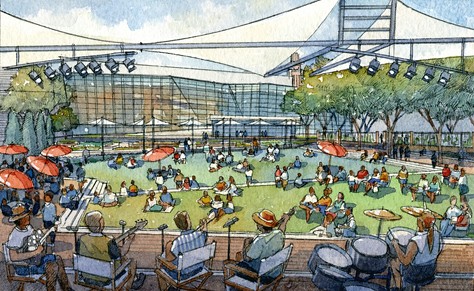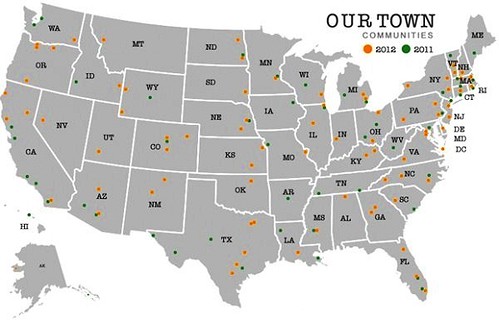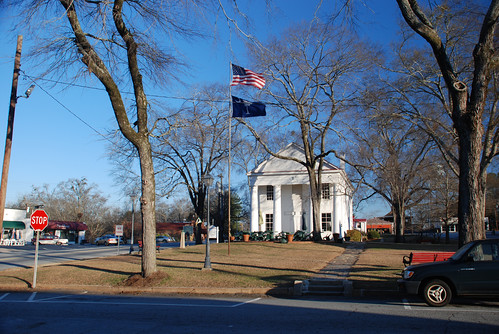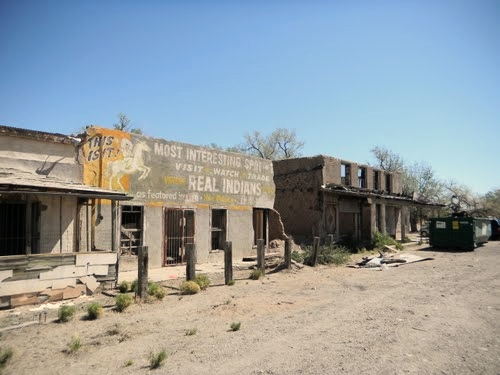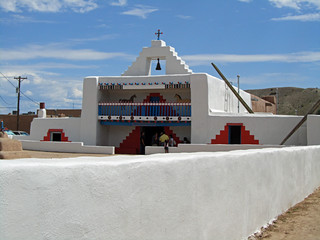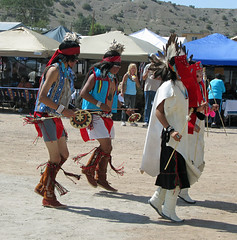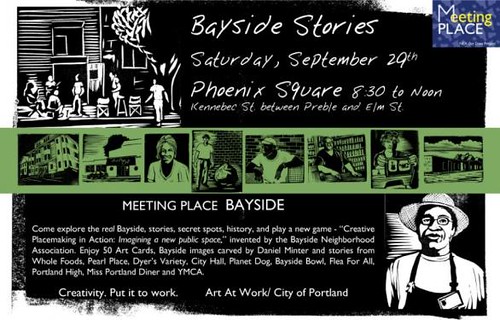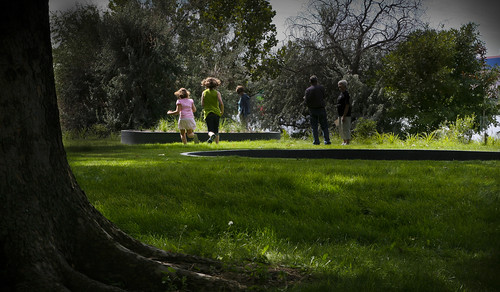The power of "creative placemaking"

Posted January 7, 2013 at 1:32PM
A little-known but very interesting government agency, the National Endowment for the Arts, is quietly leveraging small amounts of financial assistance to make a big difference in helping communities across the country become stronger and more alive. Whether in Portland, Maine, Pendleton, South Carolina, the Kewa Pueblo in New Mexico, or another of the scores of locations that its Our Town program is assisting in all 50 states, the agency believes “creative placemaking” can strengthen “community identity and a sense of place, and help revitalize local economies.” I couldn’t agree more.
Indeed, music, film, the visual arts, and even design tend to get us gathering and talking together, frequently in the same place. Sometimes they reinforce a shared sense of culture; sometimes they provoke us (and others) to think of our communities in new ways; sometimes they are just fun. (Do not discount happiness as important to sustainability.) Often they create vital, new identities or “brands” in cities, towns, and neighborhoods.
Among big-time examples, Bilbao, Spain and Sydney, Australia have become world-famous in no small part because of those cities’ famed, high-concept Guggenheim Museum and Opera House, respectively. In the US, New Orleans without its strong musical culture is almost unthinkable. Growing up in my hometown, you could count on the Mountain Dance and Folk Festival kicking off “’long about sundown” every year on a weekend in August. 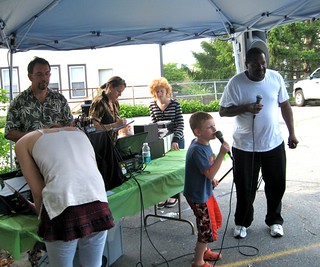 (The festival may be gone, but Asheville remains an arts mecca.)
(The festival may be gone, but Asheville remains an arts mecca.)
I particularly love how art and music can rejuvenate individual neighborhoods, as with the revitalization of Northwood in West Palm Beach, or the injection of pride into a once-rundown Houston neighborhood where Project Row Houses now celebrates African-American art and community. In many cases, the revitalization would never have taken place without the interest and energy of the creative community.
The Our Town program
Several months ago, I wrote about the National Endowment’s support of the public-private partnership ArtPlace, which is doing great work in this arena. But NEA also has its own program, called Our Town after the much-loved Thornton Wilder classic. Last July, the agency announced 80 grants to support creative placemaking in 44 states and DC. Combined with grants from 2011, the NEA has invested over $11 million in Our Town projects in all 50 states and the District of Columbia, according to a press release.
The program was conceived by the Endowment’s chairman, Rocco Landesman, and is led by NEA director of design Jason Schupbach. (Schupbach’s predecessor at NEA was Jeff Speck, who coined the “ten steps of walkability” that I described last month.) While the agency has recognized for some time that design can be marshaled to strengthen communities, Our Town has brought a new focus to its work, centered on placemaking through explicit creative activity. I like that the program stresses smaller cities and towns: 41 of the 80 grants awarded last July went to communities with populations under 50,000 and five of them went to communities with fewer than 1,000 residents.
Schupbach summarizes what the program does:
"We fund partnerships led by arts and design organizations and local governments to implement projects that contribute toward the livability of communities and help transform them into lively, beautiful, and sustainable places with the arts at their centers. More specifically, we support planning, design, and arts engagement projects that: encourage creative activity; create community identity and a sense of place; improve quality of life; and revitalize local economies."
The agency says that within the 80 projects are 566 different partners, including 240 arts agencies and organizations. Other partners include “aging services agencies, botanic gardens, religious institutions, and scientific organizations; local businesses, including banks and farms; business improvement districts, educational institutions; local, state, and federal government agencies; and land trusts.”
So many of the projects that this program supports look so good to me that it’s hard to choose examples. But here are a few:
Pendleton, South Carolina: strengthening the center
Pendleton is a small rural community with a population of approximately 3,000 residents. The entire town is on the National Register of Historic Places but, as with so many traditional towns, its character has in some ways been eroded over the years as investment went elsewhere. Its historic town square has become poorly defined by surrounding properties, depriving the community of a strong focal point. But Pendleton remains popular with visitors, drawing some 50,000 each year.
NEA is helping the town, Clemson Little Theater, and five local organizations work with landscape architects and urban designers to create a master plan to renovate the town square. The plan will include designs for the surrounding streetscape, public art, and performance spaces to foster cultural activity. The 2012 Our Town grant builds upon a previous community visioning exercise supported by NEA’s Citizens' Institute on Rural Design. (The CIRD is now operated as a partnership among NEA, the US Department of Agriculture, the Orton Family Foundation, the Community Matters Partnership, and one of my favorite nonprofits, the Project for Public Spaces.)
Kewa (Santo Domingo) Pueblo, New Mexico: a cultural district
The Kewa Pueblo, located between Albuquerque and Santa Fe, is currently occupied by more than 3,600 tribal members. It, too, is listed on the National Register of Historic Places. The pueblo has a strong cultural tradition but also some serious social challenges, including 25 percent of tribal members living below the poverty level and a 23 percent unemployment rate. Its once-iconic trading post was destroyed by fire in 2001 and is only now being rebuilt. (Kewa is also known as the Santo Domingo Pueblo, the name it was given by the Spanish in the 1600s.)
There are also some positive signs in the community, including a new facility to house safety services and a new Head Start/Early Childhood Learning Center. There is a rail station with links to Santa Fe and Albuquerque.
NEA is helping tribal authorities, Enterprise Community Partners, Cornerstones Community Partnerships, the Sustainable Native Communities Collaborative, and Atkin Olshin Schade Architects create a cultural district plan for the pueblo that could form the basis for economic development. In particular, the plan will document the heritage of the Kewa/Santo Domingo Tribe and establish culturally appropriate guidelines for conservation of historic adobe structures and for compatible new development. The plan will also promote cultural and artistic entrepreneurship.
Portland, Maine: engaging community through shared art projects
Through a project called Meeting Place, NEA has been helping five neighborhood associations in Portland, Maine work with multidisciplinary artists-in-residence, raise funds to support a public art installation in each neighborhood, and sponsor a citywide festival that celebrates the neighborhoods and the art they created. The project has also helped the neighborhoods lead arts-centered explorations of each district’s history, assets and challenges. Media involved in the project have ranged from painting to sculpture to poetry to music to storytelling, and probably more.
The goals of the concept, developed by a nonprofit called Terra Moto and implemented through its initiative Art at Work, have been multifaceted. The idea has been to encourage civic dialogue, restore a sense of neighborhood pride and unity, engage new and diverse neighborhood voices, identify and empower community leaders, improve the quality of place, and strengthen the cultural and economic viability of neighborhoods. That sounds to me like “creative placemaking” in a nutshell.
Columbia River Basin, Washington and Oregon: environmental remembrance and restoration
The Confluence Project, based along a 300-mile stretch of the Columbia River in the states of Washington and Oregon, is decidedly not neighborhood-based, but it is strongly tied to culture and place. A decade-long collaboration among Pacific Northwest Tribes, local communities, regional civic groups, and artist Maya Lin, the project comprises public artwork installations, environmental restoration, and educational programming at seven sites important to Native Americans. It reminds me a lot of the superb Estuaire project along the Loire River between Nantes and St-Nazaire, France, using public art to draw attention to historic and natural environmental features along a major waterway.
NEA is helping the Confluence Project collaborate with the City of Dufur, Oregon and other local partners to implement the project’s final installation, located at the site of a major waterfall on the Columbia that was lost when a dam was constructed in 1957. The loss is outrageous viewed from the values of today: Celilo Falls was North America's largest salmon fishery and a nexus of economic, artistic, and cultural exchange for more than 10,000 years until it was submerged. From the Columbia River Inter-Tribal Fish Commission:
“For centuries Indians caught the giant chinook and other food salmon that struggled to make their way upstream through the rocky barrier of tumbling waters and swift, narrow channels of the Columbia River known as Celilo Falls, or Wy-am. During the spring flooding, ten times more water passed over this spectacular waterfall than passes over Niagara Falls today.
The ancient ones left a record of their lives in the ashes of campfires and buried sanctuaries of their dead. They left tools and weapons, items of adornment, and samples of their art. Their record of habitation proves Wy-am to be one of the longest occupied sites on the continent.
“For thousands of years, Wy-am was one of history’s great market places. A half-dozen tribes had permanent villages between the falls and where the city of The Dalles now stands. As many as 5,000 people would gather to trade, feast, and participate in games and religious ceremonies.”
The Celilo Falls Tribute Project will feature onsite and online interpretive features, a school-based art program, and artwork by Lin. The sculptural centerpiece of the project is the Celilo Arc, a sweeping linear viewing platform said to be inspired by the large wooden platforms built over the river by Native American fishermen before the falls were flooded.
Back to creative placemaking
These projects strike me as fantastic, and I might think that of all the others if I took the time to learn more. Strengthening community by strengthening place is, in my opinion, critical to sustainability: if we don’t have places that are worth caring about, they literally will not be sustained.
The National Endowment certainly isn’t the only game in town when it comes to creative placemaking. The Project for Public Spaces has been a leader on these issues for decades; the ArtPlace partnership has the potential to become hugely important, bringing private resources to the table; locally based artists and civic leaders have been showing the way for millennia. But having the Endowment step up is important. Speaking for an article in NEA Arts Magazine, Kelly Adams Hapner put it this way:
"Cities have long understood the opportunities to leverage cultural and artistic resources to shape the character of a neighborhood. In the last couple years, though, the National Endowment for the Arts has identified placemaking as one of its priorities and has advocated for the strategy. It's led to outstanding new opportunities to integrate arts into built environments on the city level. It's also elevated the idea of placemaking into the national conversation."
Adams Hapner is director of cultural affairs for San Jose, California.
NEA is accepting applications for the fiscal year 2013 Our Town grant program now. The deadline is January 14.
Related posts:
- How a tough neighborhood is building a stronger future with vivid public art (November 16, 2012)
- Shaping shared places to improve cities (November 13, 2012)
- Terrific short video on arts-driven placemaking (June 15, 2012)
- National arts partnership steps up big for community revitalization (June 12, 2012)
- Is placemaking a "new environmentalism"? (April 23, 2012)
- Preserving a sense of place in LA's Little Tokyo (April 9, 2012)
- The role of the arts in thriving communities (July 28, 2011)
- Arts-driven revitalization in Kentucky - yes, Kentucky (December 17, 2010)
Move your cursor over the images for credit information. The images of the church and dancers at Kewa Pueblo are copyright: Elizabeth R. Rose Photography. They also appear in this article by Rose.
